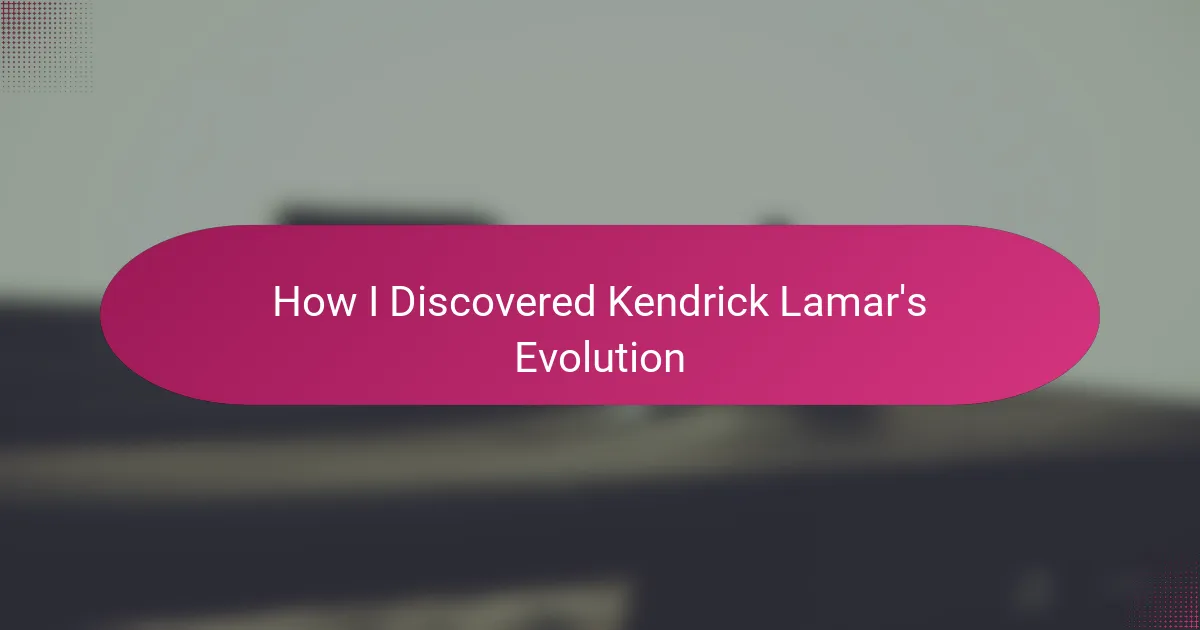Key takeaways
- Kendrick Lamar’s storytelling is deeply personal, reflecting his experiences and social issues, making his music resonate with listeners on multiple levels.
- His evolution as an artist showcases a shift from raw, gritty narratives to more complex, layered sounds that challenge and inspire listeners.
- Key albums like “good kid, m.A.A.d city,” “To Pimp a Butterfly,” and “DAMN.” mark significant points in his artistic growth, blending various genres and highlighting themes of identity and vulnerability.
- Kendrick’s willingness to embrace vulnerability and continuous reinvention emphasizes the importance of depth in art over mainstream popularity.
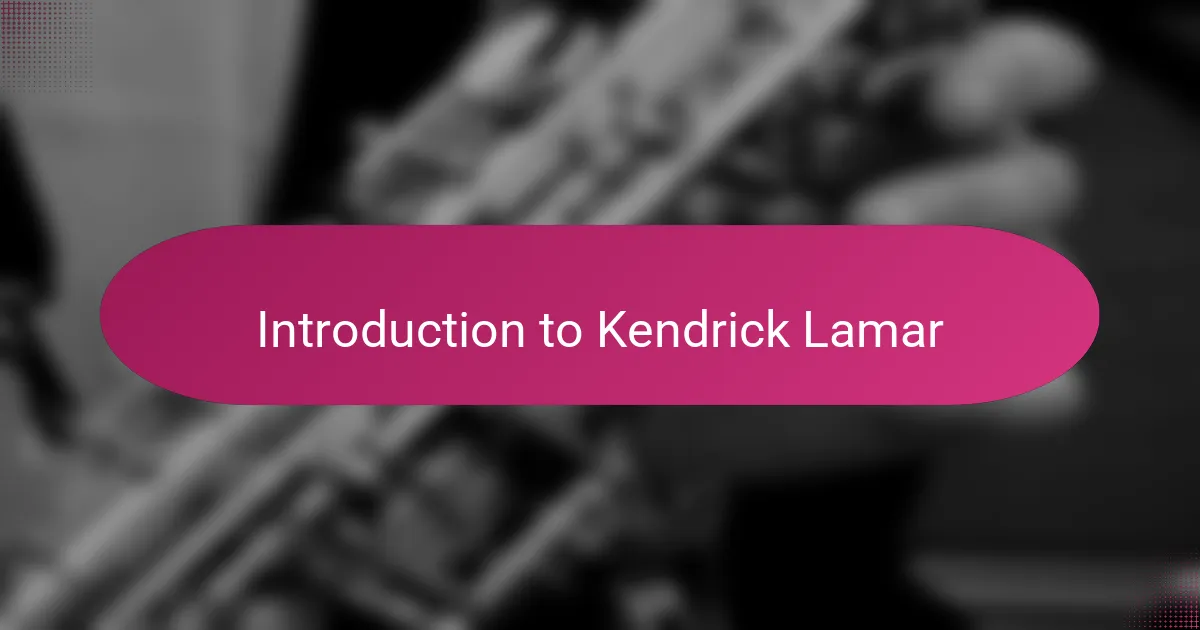
Introduction to Kendrick Lamar
Kendrick Lamar is more than just a rapper—he’s a storyteller whose words resonate deeply. When I first heard his flow, I was struck by the raw emotion and vivid imagery that seemed to pull me right into his world. Have you ever experienced music that feels like it’s speaking directly to your own struggles and dreams?
Growing up in Compton, Kendrick’s perspective is shaped by real-life challenges, which he translates into his art with an authenticity few can match. That’s what makes his journey so compelling to me; it’s like watching someone transform pain into powerful messages that inspire and provoke thought.
What makes Kendrick Lamar stand out? For me, it’s the way he navigates complex themes with poetic grace, refusing to shy away from hard truths. I often find myself reflecting on his lyrics long after the song ends, realizing there’s always more beneath the surface.
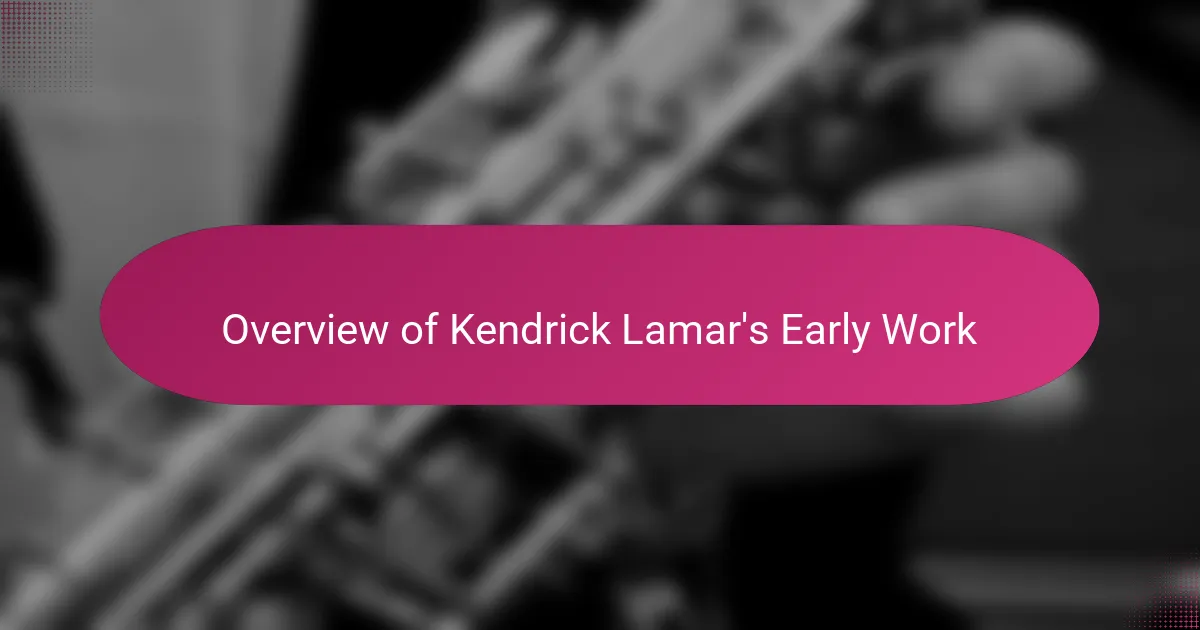
Overview of Kendrick Lamar’s Early Work
When I first explored Kendrick’s early work, what caught my attention was how raw and unfiltered it felt. His mixtapes, like Overly Dedicated, were packed with sharp storytelling and a hunger that spoke volumes about where he came from. Have you ever listened to an artist so young, yet so confident in their voice? That’s exactly how Kendrick sounded to me back then.
One thing I noticed was how he didn’t rush to mainstream polish. Instead, he embraced his gritty Compton roots, weaving struggles and observations into every track. It felt like he was inviting me into his world, sharing pieces of his life with honesty that’s often missing in popular music.
Reflecting on those early records now, I realize they set the foundation for the depth we see in his later albums. The seeds of introspection and social commentary were already there, quietly growing beneath a surface of energetic beats and compelling rhythms. It made me wonder, how many other artists start this way but don’t evolve as powerfully?
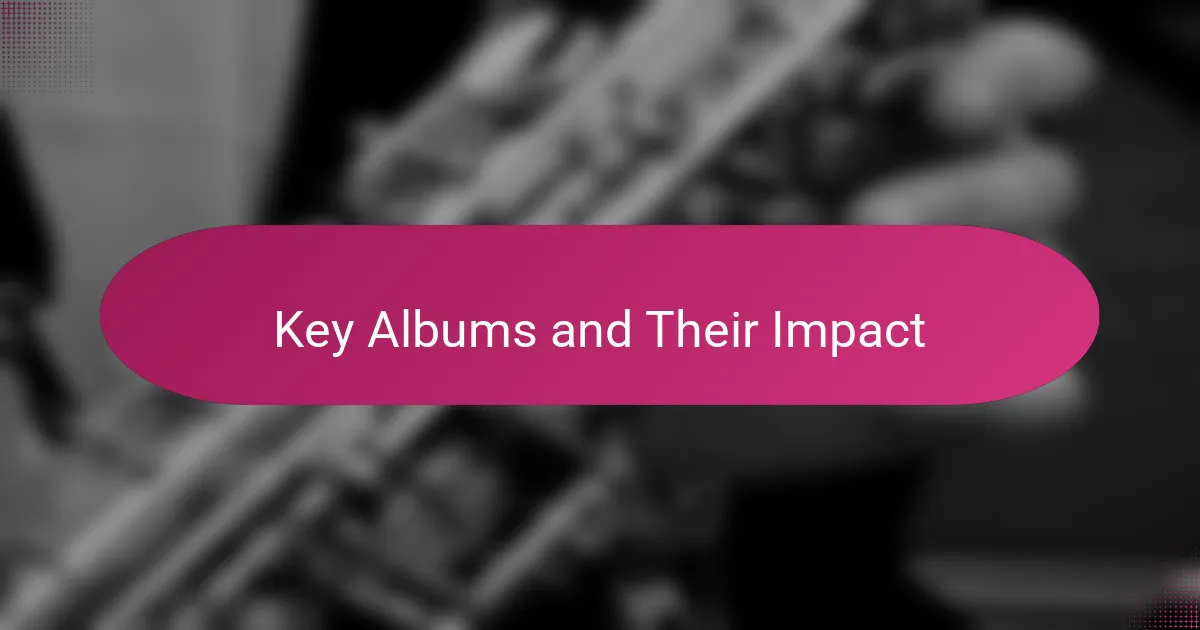
Key Albums and Their Impact
When I first dived into good kid, m.A.A.d city, it hit me like a cinematic experience—each track painting a vivid chapter of Kendrick’s life. The way he balanced storytelling with catchy hooks made the album unforgettable, and it was clear this wasn’t just music; it was a journey through youth, temptation, and survival. Have you ever listened to an album that feels like a novel, pulling you deeper with every verse? That’s exactly how this one captivated me.
Moving forward to To Pimp a Butterfly, I felt like Kendrick was challenging me to think harder about society, race, and identity. The jazzy, experimental sounds paired with fierce lyricism created a complex but rewarding listening experience. At times, I caught myself rewinding just to catch every nuance. Isn’t it rare to find an album that demands your full attention and reflection like this?
Then came DAMN., which struck me with its raw honesty and versatility. Kendrick’s ability to blend vulnerability with boldness in lyrics reminded me how far he’d evolved as both an artist and a person. I remember thinking, “This album feels like a conversation with Kendrick himself.” Has any other rapper made you feel so personally connected through their music? For me, these albums mark key points in his evolution that shaped how I view rap as pure storytelling and art.
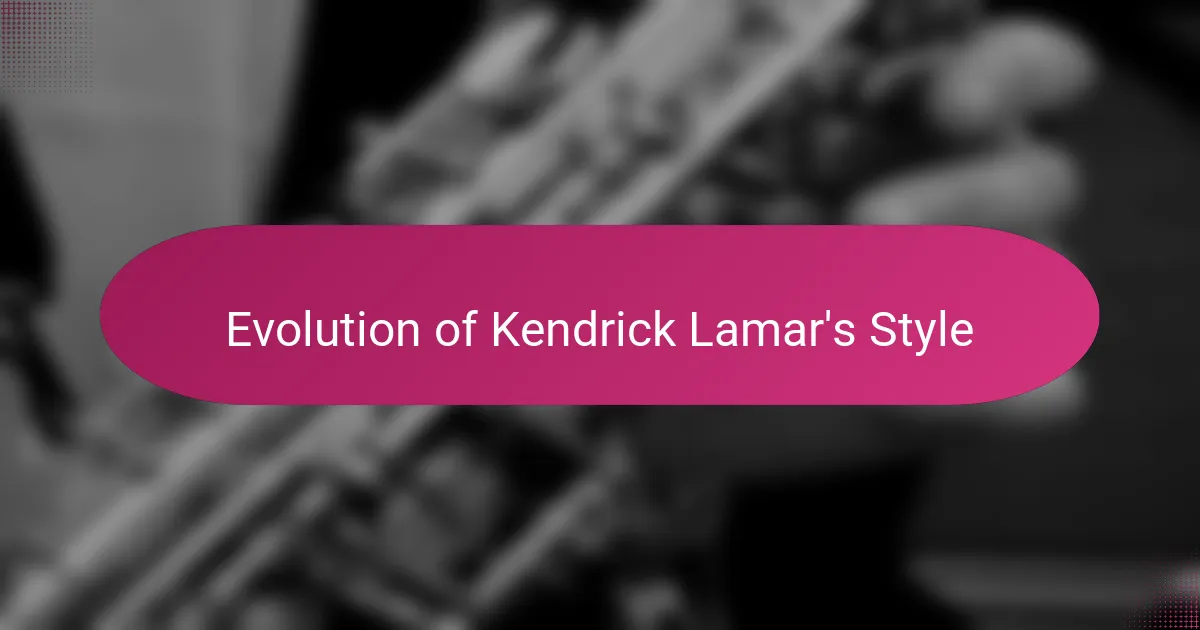
Evolution of Kendrick Lamar’s Style
I’ve always admired how Kendrick’s style never stays in one place. Early on, he was all about gritty storytelling and rapid-fire flow that pulled me into his Compton roots, but over time, his sound morphed into something richer and more layered. Have you noticed how his music shifts from raw energy to something almost cinematic, with each beat and lyric carefully crafted to challenge and inspire?
What really fascinates me is how Kendrick blends genres and moods without losing his core voice. Take To Pimp a Butterfly—it’s not just rap; it’s a fusion of jazz, funk, and soul, wrapped in deeply political and personal themes. Experiencing that album felt like stepping into his mind, trying to unravel his complex thoughts and emotions. Isn’t it powerful when an artist takes risks and grows right before your ears?
By the time DAMN. dropped, I was struck by Kendrick’s newfound simplicity mixed with emotional depth. His style became more direct, yet still layered with meaning, like having a heartfelt conversation that swings between vulnerability and defiance. It made me realize that evolution doesn’t always mean complexity—it can also be about clarity and connection. Have you felt that shift in his music too?
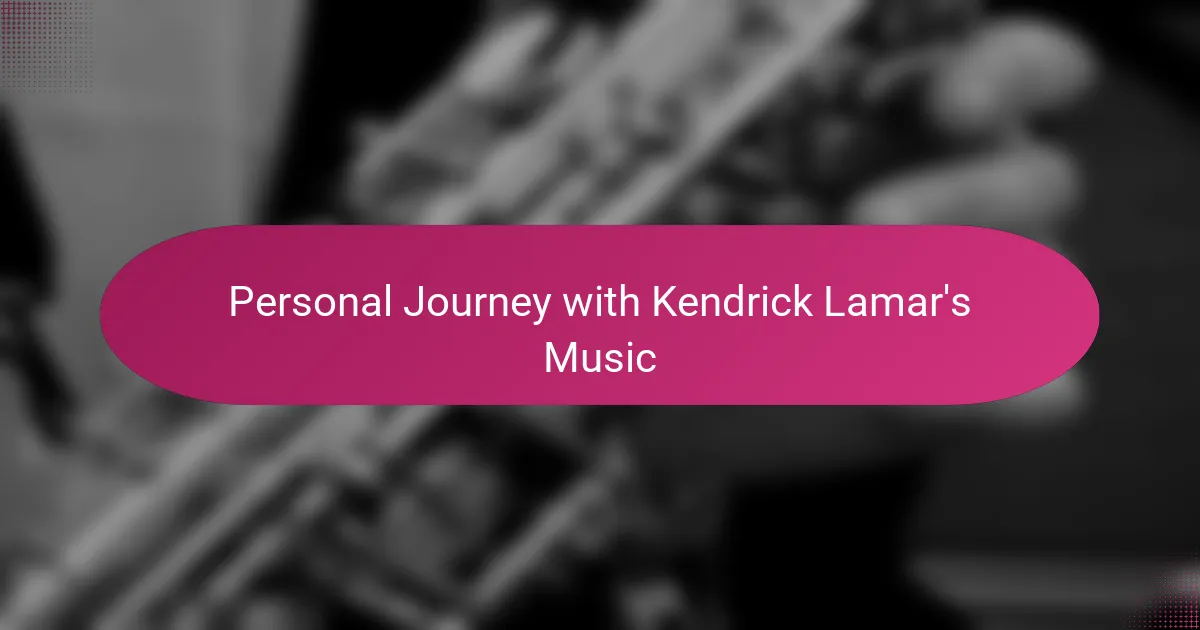
Personal Journey with Kendrick Lamar’s Music
Discovering Kendrick Lamar’s music really felt like uncovering a hidden world. I remember the first time a friend played one of his tracks for me—I was struck by how deeply personal and honest it felt. Have you ever had that moment when a song suddenly connects with your own experiences, almost like it was written just for you?
As I kept listening, it became clear that Kendrick’s music was evolving alongside my own life. There were times when a new album seemed to capture exactly what I was feeling, whether it was confusion, hope, or frustration. It’s rare for an artist to grow in such a way that their work mirrors your personal journey so closely.
What stood out the most to me was how each phase of Kendrick’s career invited me to reflect differently. Sometimes I found myself questioning society’s norms, other times I was simply moved by the beauty of his wordplay. Have you ever followed an artist not just for their sound, but because their evolution challenges you to think—and feel—more deeply? That’s the kind of connection I’ve had with Kendrick’s music.
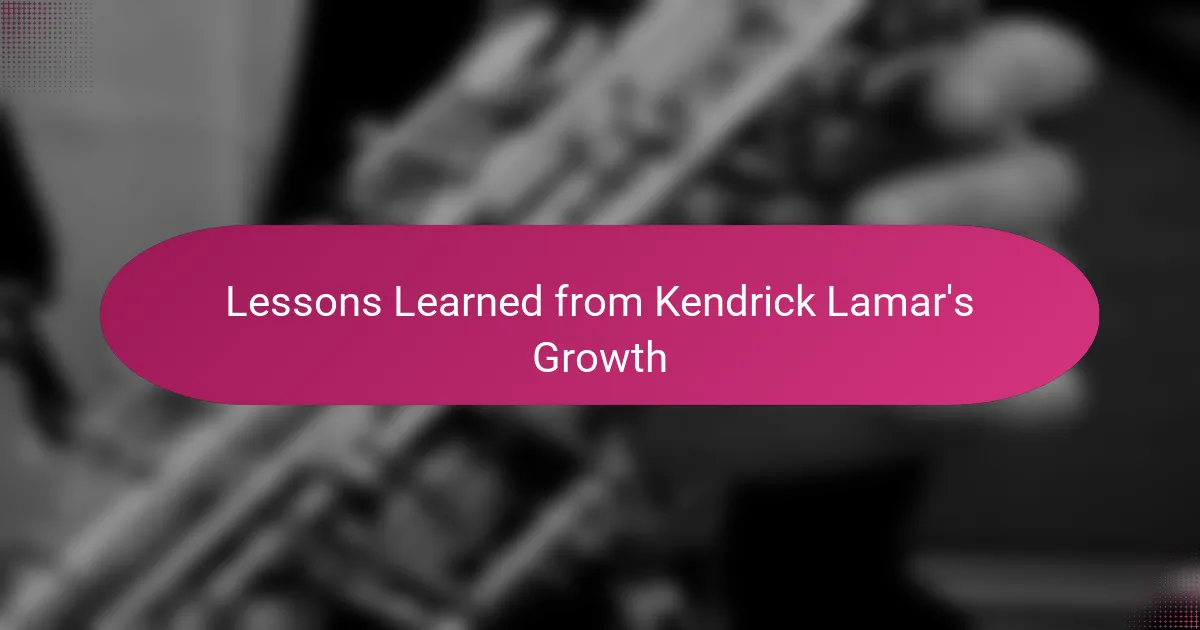
Lessons Learned from Kendrick Lamar’s Growth
One lesson I’ve taken from Kendrick Lamar’s growth is the power of vulnerability in art. Watching him openly confront his struggles, fears, and doubts made me realize how courage can transform pain into something meaningful. Have you noticed how his willingness to be raw invites listeners to be honest with themselves too?
Another insight is the importance of continual evolution. Kendrick never settled into one style or message; he challenged himself to explore new sounds and ideas, which kept his music fresh and impactful. It made me think—if an artist like Kendrick can reinvent himself while staying true to his roots, what about the ways we can grow in our own lives?
Finally, Kendrick taught me that depth matters more than popularity. His music demands attention and reflection, proving that success isn’t just about catchy hooks but also about substance. Isn’t it inspiring to see someone prioritize meaningful expression over easy fame? That’s a lesson I carry with me whenever I listen to his work.
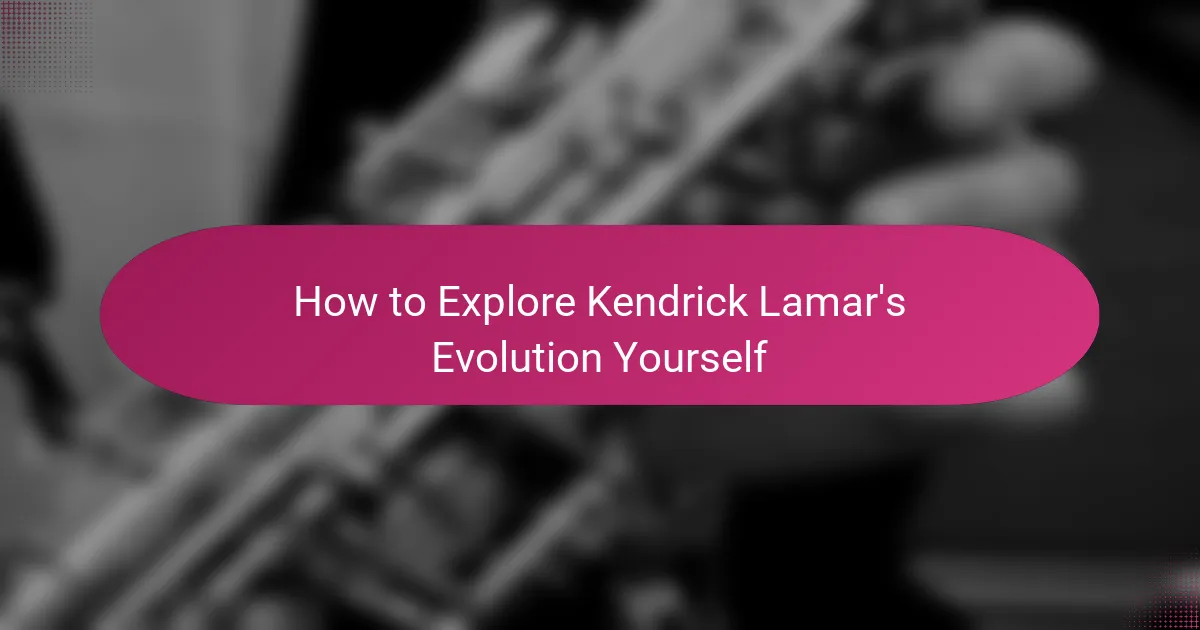
How to Explore Kendrick Lamar’s Evolution Yourself
If you want to explore Kendrick Lamar’s evolution yourself, start by listening to his albums in chronological order. Trust me, hearing how his sound and themes shift from Section.80 to Mr. Morale & the Big Steppers gives you a real sense of how he grows both artistically and personally. Have you ever noticed the way an artist’s early work captures raw energy, while later projects dive deeper into reflection and experimentation?
Don’t just listen—read his lyrics carefully. Kendrick’s wordplay is dense and layered, and I’ve found that taking time to unpack his verses often reveals hidden meanings and social commentary that aren’t obvious on the first listen. Sometimes I like to write down lines that strike me and ponder what they mean in different contexts; it’s like having a conversation with Kendrick’s mind across time.
Lastly, pay attention to the production and musical influences on each record. I’ve seen how Kendrick’s collaborations with producers and his embrace of jazz, funk, and soul elements shape the mood and message of his albums. Have you ever felt how a beat or instrumental can completely change the feeling of a lyric? Exploring these sonic changes adds a whole new layer to understanding his evolution.
